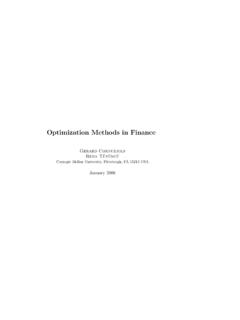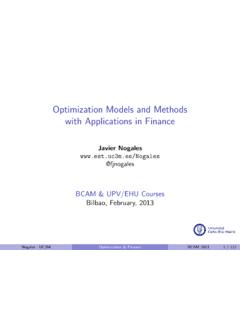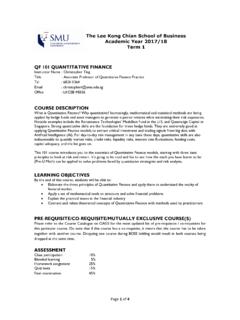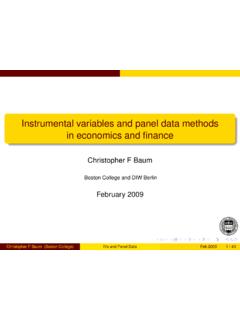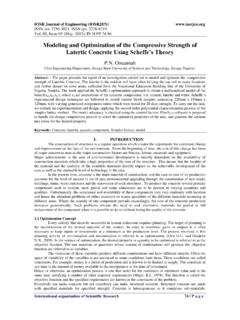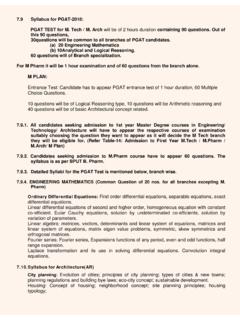Transcription of Optimization in Finance: Portfolio selection models
1 Optimization in finance : Portfolio selection modelsEnriqueta VercherDepartament d Estad stica i Investigaci o OperativaUniversitat de Val`enciaSpainIBERIAN CONFERENCE IN OPTIMIZATIONC oimbra 2006 IBERIAN CONFERENCE IN Optimization , Coimbra 2006 p. 1/59 AbstractPortfolio selection problem deals with how to form a satisfying Portfolio ,taking into account the uncertainty involved in the behavior of the (1952)established the relationship between the mean andvariance of the investment in the framework of risk-return trade-off. Sincethen a variety of enlarged and improved models have been developed inseveral models of Portfolio management combines probability theory andoptimization theoryto represent the behavior of the economic representations of return and risk have permitted to apply differentoptimization tools to the Portfolio CONFERENCE IN Optimization , Coimbra 2006 p.
2 2/59 AbstractIn this talk we provide some new models for Portfolio selection in which thereturns on the securities are considered as fuzzy numbers rather thanrandom order to find the Portfolio that minimizes the risk in achieving a given levelof return we introduce different approaches. In some of themthe expectedtotal return is considered otherwise is the fuzzy total return on each asset and their membership functions are describedusing historical data and the risk of the investment is approximated by usinginterval-valued means which evaluate the downside risk fora order to illustrate the performance of our methods we haveused weeklyreturns corresponding to a selection of assets from the Spanish CONFERENCE IN Optimization , Coimbra 2006 p.
3 3/59 OutlinePortfolio selection modelsPortfolio selection with fuzzy returnsFuzzy backgroundFuzzy downside risk modelsPortfolio selection with linear programsPortfolio selection with semi-infinite optimizationNumerical examplesIBERIAN CONFERENCE IN Optimization , Coimbra 2006 p. 4/59 OutlinePortfolio selection modelsPortfolio selection with fuzzy returnsFuzzy backgroundFuzzy downside risk modelsPortfolio selection with linear programsPortfolio selection with semi-infinite optimizationNumerical examplesIBERIAN CONFERENCE IN Optimization , Coimbra 2006 p. 5/59 Portfolio selection modelsModern Portfolio selection theory usually deals with two opposite concepts:risk aversion and maximization of returns. The main point ofthe modellingof this problem is how the risk and assets profitability are defined models consider an asset return as a random variableand itsprofitability is defined as the mathematical expectation of that randomvariable, while the risk of the Portfolio is measured by means of the formulation of the mean-variance model a variety of enlarged andimproved models have been developed in several dealt withalternative Portfolio selection models , for instance, a mean-semi-variancemodel, a mean-absolute deviation model or mean-downside risk approach concerned the modelling of uncertainty and theknowledge of the experts provided by fuzzy set CONFERENCE IN Optimization , Coimbra 2006 p.
4 6/59 Portfolio selection modelsIn a standard formulation of Markowitz model(Mean-Variance)we have thefollowing quadratic programming problem, for a given expected return :MinPnj=1 Pni=1 (Rj) Pnj=1xj= 1lj6xj6ujj= 1.. nxjis the percentage of investment in the assetjthRjis the random variable representing the return of assetjth ijis the covariance betweenRiandRjlj, ujrepresent the maximum and minimum amount of the total fund whichcan be invested in the assetjthIBERIAN CONFERENCE IN Optimization , Coimbra 2006 p. 7/59 Portfolio selection modelsAccording toKonno and Yamazaki(1991), the (MV) problem is equivalent to thefollowingmodel (MAD), which minimizes the sum of absolute deviations from theaverages associated with thexjchoices, when the assets are multivariatenormally distributed:MinE(|Pnj=1 Rjxj E(Pnj=1 Rjxj)|) (Rj) Pnj=1xj= 1lj6xj6ujj= 1.
5 NThis approach permits to avoid one of the main drawbacks associated tothe solution of theMean-Variance (MV) model: the input problem ofestimating2n+n(n 1) CONFERENCE IN Optimization , Coimbra 2006 p. 8/59 Portfolio selection modelsThe(MAD)problem can be converted in a finite LP problem replacing itsobjective function by:Min(1/T)PTk= yk+Pnj=1(rjk E(Rj))xj 0k= 1.. Tyk Pnj=1(rjk E(Rj))xj 0k= 1.. T(1)where the observation of the assets returns overTperiods are given andrjkdenotes the return of thejthasset at the model (LMAD)gives portfolios which involves fewer non-zerocomponents and hence reduces the numerous small transactions that arelikely to appear in the (MV) CONFERENCE IN Optimization , Coimbra 2006 p. 9/59 Portfolio selection modelsSimaan (1997)stated that although the minimization of mean-absolutedeviation is close to the(MV)formulation they lead to two different efficientsets.
6 The divergence between the two models is due to the factthat eachmodel utilizes different sample statistics and consequently relies on adifferent set drawn from the the return is normally distributed the minimization of(LMAD)providessimilar results as the(MV)formulation but the normality assumption rarelyis verified in practice, then different portfolios can be diceet al(2003)studied the stability of the portfolios, their expected return and thecomputational time using both models in real-life capital market andconclude that none model is superior to the models have also been compared with out-of-sample datafrom sharestraded in the Stockholm Stock Exchange(Papahristodoulou and Dotzauer,2004)and the(MV)model yields higher utility levels and higher degrees ofrisk aversion in very similar computing CONFERENCE IN Optimization , Coimbra 2006 p.
7 10/59 Portfolio selection modelsThe dissatisfaction with the traditional notion of variance as a measure of risk isdue to the fact that it makes no distinction between gains andloses. In particular,Markowitz(1959)also proposed to use thesemi-variancew(x) = E((m ax{0,E(nXj=1 Rjxj) nXj=1 Rjxj})2).From then, several Optimization models which consider onlythe downside risk ofa Portfolio have been introduced. If the risk is measured by means of themean-absolute semi-deviation, as proposedSperanza(1993), we have thefollowing downside risk functionw(x) = E(|m n{0,nXj=1 Rjxj E(nXj=1 Rjxj)}|).which can be easily evaluated in contrast with the complexity of computing thesemi-variance of a given CONFERENCE IN Optimization , Coimbra 2006 p.
8 11/59 OutlinePortfolio selection modelsPortfolio selection with fuzzy returnsFuzzy backgroundFuzzy downside risk modelsPortfolio selection with linear programsPortfolio selection with semi-infinite optimizationNumerical examplesIBERIAN CONFERENCE IN Optimization , Coimbra 2006 p. 12/59 Portfolio selection with fuzzy returnsDifferent elements can be fuzzified for managing the Portfolio selection authors use possibility distributions to model the uncertainty on thereturns(Tanaka y Guo,1999; Carlssonet al,2002; Huanget al,2006).Fuzzy numbers can also represent the decision maker aspiration levels forthe expected return and risk(Watada,1997; Arenaset al,2000).The imperfect knowledge of the reality can be introduced by means of fuzzyquantities and/or fuzzy constraints(Ort et al,2002; Leonet al,2002).
9 In our approach we propose somefuzzy modelsfor Portfolio selection based ontwo issues:the approximation of the rates of return on securities by means of fuzzynumbers, andthe perception that thedownside riskis a more realistic description of thepreferences of the investor, because this risk function only penalizes thenon-desired CONFERENCE IN Optimization , Coimbra 2006 p. 13/59 Portfolio selection with fuzzy returnsWe consider a capital market withnrisk assetsoffering uncertain the proportion of the total investment fund devoted to assetjth, theuncertaintyon the return of assetjthis modelled by means offuzzyquantities Rj= (alj, auj, cj, dj)LRforj= 1,2, .. , nandRfis the rate ofreturn on the risk-less Portfolio may be denoted byP(x) ={x1, x2.}
10 , xn}and thetotalreturnon the fuzzy Portfolio is a convex linear combination of the individualasset returns, as follows: RP(x) =nXj=1xj Rj,Different definitions of theaverage of a fuzzy numbercan be used toevaluate both the expected return and the risk of a given portfolioP(x).IBERIAN CONFERENCE IN Optimization , Coimbra 2006 p. 14/59 Portfolio selection with fuzzy returnsDubois and Prade(1987)introduce the mean interval of a fuzzy number asa closed interval bounded by the expectations calculated from its lower andupper probability mean ,Carlsson and Full r(2001)define an interval-valuedpossibilistic mean of fuzzy numbers, their definition beingconsistent withthe extension principle and also based on the set of the measure of investment risk, we will use afuzzy downsiderisk functionintroduced inLeonet al.
